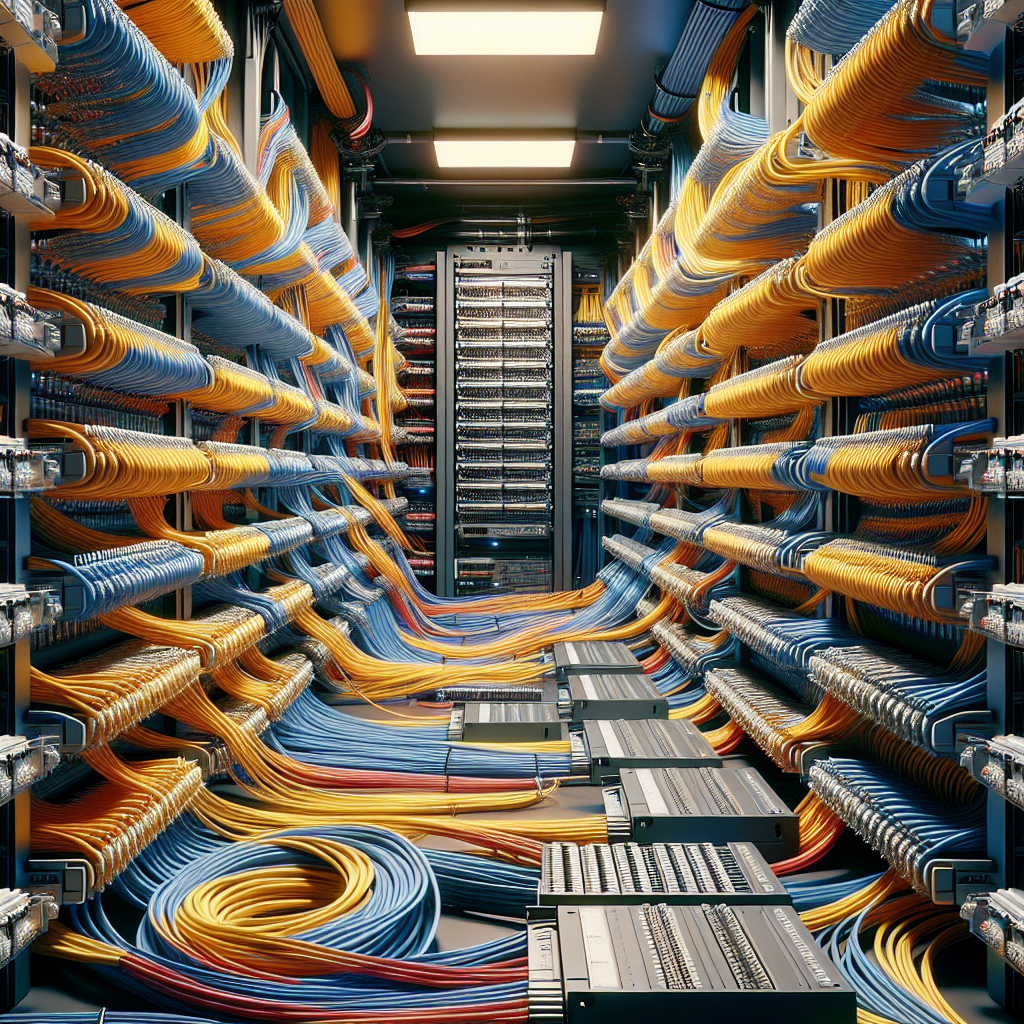In today’s highly connected world, having a robust and efficient networking infrastructure is crucial for any business or residential setting. *Structured cabling* forms the backbone of this infrastructure, providing a standardized approach to the physical connections and layout of your network. But *what is structured cabling and what are its six components*? Structured cabling refers to a system of cabling and associated hardware that provides a comprehensive telecommunications infrastructure. This infrastructure serves a wide range of uses, including data transmission, telephone services, and video conferencing.
Unlike traditional point-to-point cabling, structured cabling is designed to be more organized, scalable, and flexible. This means easier management, reduced downtime, and the ability to meet the ever-growing demands of modern technology. Whether you are setting up a new office, expanding an existing network, or upgrading your current system, understanding the fundamentals of structured cabling is essential.
Visit our website to learn more and get started today! Click here.
Benefits of Structured Cabling Systems
**Structured cabling systems** offer numerous benefits that can significantly enhance the efficiency and reliability of your network infrastructure. One of the most notable advantages is the *improved organization* it provides. By using standardized cabling practices, you can avoid the tangled mess and confusion often associated with traditional cabling systems. This organization makes it much easier to identify and resolve issues quickly, minimizing downtime.
Another key benefit is *scalability*. Structured cabling systems are designed to grow with your business. Whether you need to add new devices, expand your office space, or upgrade your technology, a well-planned structured cabling system can easily accommodate these changes without requiring a complete overhaul. This flexibility can save you both time and money in the long run.
**Enhanced performance and reliability** are also critical advantages. Structured cabling systems use high-quality cables and components that are designed to meet rigorous standards. This ensures that your network operates at peak efficiency, providing faster data transfer rates and reducing the risk of signal interference or data loss. Additionally, structured cabling supports a wide range of applications, from voice and data to video and multimedia, making it a versatile solution for any business needs.
Lastly, *cost efficiency* should not be overlooked. Although the initial investment in a structured cabling system may be higher than traditional cabling, the long-term savings are substantial. Reduced maintenance costs, lower downtime, and the ability to easily upgrade your system all contribute to a more cost-effective solution over time.
Overview of Six Key Components
Understanding the six key components of a **structured cabling system** is essential for optimizing your business’s network infrastructure. These components work together to create a robust and efficient system that meets your connectivity needs.
The first component is the *entrance facilities*, which include the cables, network demarcation points, and other equipment that connect your building to the external network. This is the critical point where your internal network interfaces with the outside world.
Next, we have the *backbone cabling*. This component provides the primary pathways for data to travel between different areas of your building or campus. Backbone cabling typically includes vertical cabling between floors and horizontal cabling across large distances.
The third component is the *horizontal cabling*, which connects individual workstations and devices to the main network via telecommunication outlets in each work area. This cabling runs horizontally from the telecommunications rooms to the end-user devices.
**Work area components** form the fourth key element. These include all the devices and equipment located in an individual user’s workspace, such as computers, phones, and network outlets. Proper configuration and installation of these components are vital for ensuring seamless connectivity.
The fifth component is the *telecommunications rooms*, also known as wiring closets. These rooms house the equipment and cabling that interconnect the backbone and horizontal cabling systems, including patch panels and network switches. Effective management of these rooms is crucial for network performance and maintenance.
Lastly, we have the *cabling pathways and spaces*. These include the conduits, cable trays, and other infrastructure that support and protect the cabling throughout your building. Proper planning and installation of these pathways ensure that cables are safely and efficiently routed, reducing the risk of damage and interference.
Horizontal Cabling Systems Explained
**Horizontal cabling systems** are a critical component of structured cabling, providing the essential links that connect individual workstations and devices to the main network. Understanding this system is crucial for ensuring efficient and reliable data communication within any organization.
Horizontal cabling typically runs from the telecommunications rooms (also known as wiring closets) to the work area outlets on the same floor. This cabling is responsible for linking the network’s central points to the end-user devices, such as computers, phones, and printers. The standard maximum distance for horizontal cabling is 90 meters, ensuring optimal performance and minimizing signal loss.
The system includes several key components:
- Telecommunications Outlets: These are the network ports located at each workstation, allowing devices to connect to the network.
- Patch Cords: Short cables used to connect devices to the telecommunications outlets.
- Horizontal Cables: The main cables running from the telecommunications rooms to the outlets, usually consisting of twisted pair, fiber optic, or coaxial cables.
- Consolidation Points: These are intermediate connection points that can help simplify cable management and future reconfigurations.
- Cross-Connects: These are used in the telecommunications rooms to facilitate connections between the horizontal cables and the backbone cabling or network equipment.
In addition to physical components, horizontal cabling systems must adhere to specific standards to ensure compatibility and performance. Standards such as ANSI/TIA-568 and ISO/IEC 11801 provide guidelines for cabling types, installation methods, and performance criteria, helping to maintain a consistent and reliable network infrastructure.
Proper installation and maintenance of horizontal cabling systems are essential for minimizing downtime and maximizing productivity. Regular testing and certification of the cabling can help identify potential issues before they become major problems, ensuring that your network remains robust and efficient.
Importance of Backbone Cabling
The **importance of backbone cabling** in a structured cabling system cannot be overstated. Often referred to as the network’s spine, backbone cabling provides the critical pathways that interconnect different areas, floors, or buildings within a campus or enterprise environment. This essential framework ensures that data can flow smoothly and efficiently across the entire network.
Backbone cabling typically involves high-capacity cables, such as multi-pair copper or fiber optic cables, designed to handle large volumes of data transmission. These cables link the main equipment rooms, telecommunications rooms, and entrance facilities, forming the core infrastructure that supports all other network segments.
Several key elements highlight the significance of backbone cabling:
- High-Speed Data Transfer: Backbone cabling supports high-speed data transfer rates, crucial for applications that demand substantial bandwidth, such as video conferencing, cloud computing, and large data transfers.
- Network Reliability: A robust backbone cabling system enhances the overall reliability and stability of the network. It minimizes potential points of failure and ensures consistent performance even during peak usage times.
- Scalability: Properly designed backbone cabling allows for easy scalability. It can accommodate future growth and technological advancements without requiring extensive re-cabling or infrastructure overhauls.
- Inter-Building Connectivity: In multi-building campuses or enterprises, backbone cabling provides the vital connections between buildings, ensuring seamless communication and resource sharing across the entire organization.
- Compliance with Standards: Adhering to industry standards like ANSI/TIA-568 and ISO/IEC 11801 ensures that the backbone cabling system meets performance criteria and is compatible with other network components.
Effective backbone cabling requires meticulous planning and precise execution. Factors such as cable type, pathway design, and termination techniques play a crucial role in the system’s performance and longevity. Investing in high-quality materials and following best practices during installation can significantly reduce maintenance costs and prolong the network’s lifespan.
In summary, the backbone cabling system is the cornerstone of a reliable and efficient network infrastructure. By ensuring robust data transfer capabilities and supporting future growth, it lays the foundation for seamless communication and enhanced productivity across your business or organization.
Telecommunications Room Essentials
The **telecommunications room** is a critical component in the structured cabling system, serving as the central point where backbone and horizontal cabling systems converge. This room houses essential network equipment, including patch panels, switches, routers, and servers, which are crucial for managing and distributing data throughout the network.
To ensure optimal performance and reliability, several elements are essential for a well-designed telecommunications room:
- Climate Control: Maintaining an appropriate temperature and humidity level is vital for the longevity and performance of network equipment. Proper climate control systems, such as HVAC units, help prevent overheating and equipment failure.
- Power Management: Reliable power supply, including uninterruptible power supplies (UPS) and backup generators, is crucial. These systems ensure continuous operation during power outages, protecting against data loss and downtime.
- Cable Management: Efficient cable management solutions, such as cable trays, racks, and labeling systems, help organize and route cables neatly. This not only enhances the room’s aesthetics but also facilitates easier maintenance and troubleshooting.
- Security: Implementing physical security measures, like access control systems and surveillance cameras, ensures that only authorized personnel can enter the telecommunications room. This safeguards sensitive equipment and data from unauthorized access.
- Fire Suppression: Installing fire suppression systems, such as fire extinguishers and automatic sprinklers, is essential to protect against fire hazards. These systems help mitigate damage and ensure safety in case of emergencies.
Effective planning and design of the telecommunications room can significantly impact network performance and reliability. By incorporating these essentials, businesses can create a robust and efficient network infrastructure that supports their operational needs.
Ready to optimize your telecommunications room and overall network infrastructure? Visit our website to learn more and get started today! Click here.





